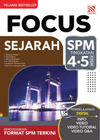 Pelangi Publishing, RM39.95, ISBN 978-629-498-098-3
Pelangi Publishing, RM39.95, ISBN 978-629-498-098-3
Education, 2025




Sejarah, or History in Bahasa Melayu, is both a must-pass Sijil Pelajaran Malaysia (SPM) subject, for those that wish to continue pursuing their college or pre-university studies at a government-run educational institution, as well as a fiendish subject due to the amount of memorization and writing needed to do well in the paper.
However, the paper itself has taken an even more fiendish turn, at least in the opinion of some candidates, because it is no longer content to ask candidates to regurgitate facts. Yes, like all SPM papers, it pushes KBAT (Kemahiran Berfikir Aras Tinggi; High Order Thinking Skills or HOTS in English) which requires candidates to give government-approved rhetorics as answers to these questions.
Authors
The publisher is as usual coy about the credentials of these authors, although Masariah Mispari recently received the Tokoh Guru Kebangsaan 2024 award.
Design
Pretty standard design, with lots of colors.
Text is crammed into two columns on pretty much every page. It looks tad cluttered, but most of the content are arranged in tables, charts, and diagrams for easier reading, so it’s not that bad.
Content and KBAT
Unlike in other reviews, I’m combining my thoughts on KBAT and the overall content in one section because the main strength in Focus SPM: Sejarah is its updated approach to KBAT questions.
Unlike the one put out by Sasbadi, the authors here highlight the use of visual stimuli in KBAT questions. There is also a preface on how to answer KBAT essays, particularly the standard 8-mark ones in Part B of Kertas 2.
Given that KBAT questions contribute to 40% of the overall score of Kertas 2, doing well in them could help one pass the paper, given how low the passing score of the paper is.
However, this is where I raise my likely unpopular opinion that KBAT questions for Sejarah are among the easiest in all the SPM subjects because, instead of actually testing the candidates’ analytical skills, they require to candidate to vomit up accepted government-approved narrative. If the candidate has a decent understanding of how to handle the karangan respons terhad and rumusan parts of the Bahasa Melayu paper as well as, for non-Muslims, the entire Pendidikan Moral paper, then KBAT should be a non-issue if one has also a decent understanding of the historical situation highlighted by the visual stimulus.
So yes, while it’s great that this book highlights the latest types of KBAT questions in the Sejarah paper and how to approach them, this feature serves either as a confidence-booster for some candidates or a possible non-issue with more proficient candidates.
The rest of the content is pretty standard for a SPM Sejarah reference book.
This brings me to another matter when it comes to this book.
Value for Money
The reference notes are presented mostly in tables, diagrams, and charts. This makes it great for quick references, but it also raises another question: why would anyone pay RM33.95 for this when the reference notes resemble those in the much cheaper quick revision Sejarah book in the publisher’s Ranger line?
It’s not like there are many practice questions here to make up for that: each chapter only offers 8 multiple choice questions, 1 structured question, and 1 essay question. That’s all. It does offer two trial exam papers, one for the year-end Form Four exam and one practice SPM paper, but on the whole, the number of practice questions here is a fraction of those found in other publishers’ reference books.
This is, sadly, the SOP of the publisher these days: cut cost, print fewer pages, and push customers to buy more books on the subject.
At RM33.95, this is just slightly more expensive than other Sejarah reference books out there, but it offers far less for that price. Yes, it highlights the KBAT stuff, but because there are so few practice questions here, one won’t be getting ample practice opportunities unless they buy the practice question book, which seems suspiciously the intention of this publisher.
Conclusion
- Presentation and design – okay.
- It is very up to date on KBAT stuff.
- However, the rest of the book doesn’t offer much for the cover price one has to pay for it. The practice questions are surprisingly few.
- The reference notes are structured in a manner typical of a quick reference book style—so why would one buy this book when they could buy a much cheaper quick reference book?
- To conclude, this book does it job well and it’s far more current than Masterclass SPM: Sejarah, but the latter offers the much more useful audio notes on top of a more extensive reference note section as well as far more practice questions.
- However, I’d suggest skipping both and get instead Success Plus SPM: Sejarah from EPH Publishing, as that one is this book with a lot more goodies and extra!
